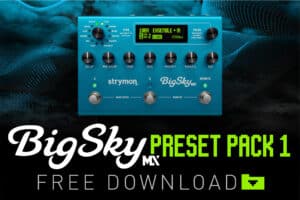
BigSky MX Preset Pack 1
Explore Our First BigSky MX Preset Pack! As part of the latest Nixie 2 update, we’ve put together a free BigSky MX preset pack featuring sounds
Free US Shipping On Orders Over $49
Easy 30-Day Returns
Financing Available Through ![]()
In today’s Artist Feature, we’re talking to guitarist Jacob Blizard. He is the guitar player for acclaimed singer-songwriter Lucy Dacus, who is set to release her third album Home Video on June 25th.
We’re excited to talk to him about what he looks forward to the most when touring again this fall, as well as what gear he has been using lately.
Hey Jacob! Thanks for taking the time to chat with us. We hope you’re doing well. What have you been up to this last year or so? Anything you’ve been doing to stay creative during quarantine?
I feel like the past year has felt both infinitely long and surprisingly short. Like, I spent three or four months doing little else besides watching all 40 seasons of Survivor… but I also started getting a little more serious about my home recording setup, and have been having a lot of fun with that. It’s nothing fancy, but it’s enough to record guitars pretty well, and really I can do almost anything besides drums.
So I’ve done a few things with friends, as well as a couple of folks who have reached out to me over Instagram. Anything from recording a guitar or bass for a mostly-finished song to pretty much building a whole arrangement from scratch. It’s not the ideal workflow—I’ll usually record things at home, then send to the artist for notes, and go back and forth a few times like that. So it’s slow, but everything is slow these days, and it’s a great experience for potential future collaborations!
For some of our readers who might not be familiar with your work, you are currently the guitarist for singer-songwriter Lucy Dacus. Can you tell us the story of how you started making music with her?
Lucy and I met in high school, actually. She’s told the story in interviews before (and probably more eloquently than I can), but we started hanging out at our friend Collin’s family holiday parties in maybe 9th or 10th grade?
Collin and I knew that Lucy wrote songs, and we started meeting up at Collin’s to hang out and record music. That was how we became friends and also how we started making music together. We made an EP of mostly acoustic stuff during those first few years.
After high school, I went to Oberlin Conservatory to study classical guitar, and Collin went to Berklee to study songwriting and recording. At Oberlin, they make you do a self-designed winter term project, and my senior year I asked Lucy and Collin if they wanted to make a full-length record together.
By this point Collin had graduated early from Berklee and moved to Nashville. He was interning at Reba McEntire’s studio, and was allowed to use it for free on weekends. So we went in for a day or two, finished up at another spot Collin also worked at, and that project turned into No Burden, Lucy’s first record.
What does the songwriting process for the band typically look like? Is it more on the collaborative side, or does one person generally dictate the direction of where a song will go musically?
I think Lucy is one of the best songwriters of our generation. I think there are folks who are as good as her, but I’m honestly not sure if there is anyone better. Her writing process is pretty solitary. I’m often one of the first people she shows new material to, and they’re usually either finished or very close to it. So as far as the song itself is concerned, Lucy does it herself.
The recording and arranging process is usually more collaborative. It varies from song to song. Sometimes Lucy will have a pretty strong idea of what a song should sound like. I’ll give a couple of examples from the new record (to be released June 25th).
“Going Going Gone” is an example of a song that really could work any number of ways, but Lucy really wanted this stripped-back, almost campfire vibe. So we recorded that one live in one room with three microphones (stereo room mics and one mic on Lucy’s voice), three guitars, and maybe a dozen friends singing a quiet group vocal on the choruses. Harrison Whitford from Phoebe Bridgers’ band actually played the lead acoustic on that one, and my friend Keilan Creech and I strummed chords.
On a lot of the songs, we would start by laying down a keyboard pad. Usually something without much character (we use this old Yamaha PSS-170 toy keyboard from the ‘80s a lot for this) so that it just gives a foundation of the chord changes. Lucy would do a scratch vocal to that, and then we’d start building an arrangement around the vocal. Collin and Jake started doing this a while ago, and it’s a really inspiring way to work.
The pad doesn’t force your hand in any direction the way a scratch guitar might. With a scratch guitar you inevitably end up playing things that sound good with the scratch, and it influences the arrangement inherently, just by existing. But this way, you can do whatever you want arrangement-wise and don’t have to worry that the arrangement might fall apart when you go to mute the scratch guitar.
One fun example is the song “First Time.” We laid down the pad, and then I was messing around trying to come up with a cool bass part. I happened to have this pedal called the Dream Sequence by Hologram Electronics close at hand and thought I’d try that. We ended up finding this really cool glitchy preset on that pedal, and that ended up becoming the backbone of that song. I remember Lucy saying something like “this sounds like something totally new—I haven’t heard this before.” It’s a really cool feeling when something really sounds fresh, and it’s surprisingly rare.
One of the things I love most about Lucy’s music, aside from her great songwriting, are the dynamics of the music—a lot of very quiet passages combined with distorted ones, as well as gradual buildups. Who are some of your biggest musical influences, both in regards to your playing, as well as your guitar tone?
I’ve loved the band Wilco for a long time, and Nels Cline is definitely a big influence on my guitar playing.
More recently I’ve been super into Big Thief. I think Buck and Adrianne both have such awesome and unique playing styles, and they don’t sound like anybody else.
I also love Harrison Whitford from Phoebe Bridgers’ band. He’s one of the coolest guitar players, and I desperately wish I could play like him.
A lot of times I’m trying to play guitar as if I’m not really a guitar player. Like, I try to stay away from blues pentatonic licks and the “lawyer who rocks” licks. You know, the ones you hear any time you walk into a Guitar Center…. Nothing against people who want to sound like Stevie Ray Vaughan or something, it’s mostly that I’m just not very good at that style of playing, so I try to do my own thing.
I think my years at conservatory also come into play—I essentially spent four years practicing guitar 5+ hours every day, and most of my focus was on clean and clear technique. I wouldn’t say that I play electric guitar like a classical player per se, but it definitely got me to a place where I feel like I can produce a clear tone on most instruments, and taught me the coordination to bring out melodies in more complex textures.
Lucy’s song “VBS,” which just came out May 20, has a short little baritone guitar solo which serves as a good example of what I’m talking about. I’m sort of playing the chords, but trying to bring out the melodic notes and downplay the other notes. If all the notes were the same volume, the melody wouldn’t really be recognizable, and I think the solo would be less interesting. It’s nothing revolutionary, but it’s a skill I’m glad I have.
I actually made a transcription of this song for the lyric video, so here’s the solo section in notation and tablature:
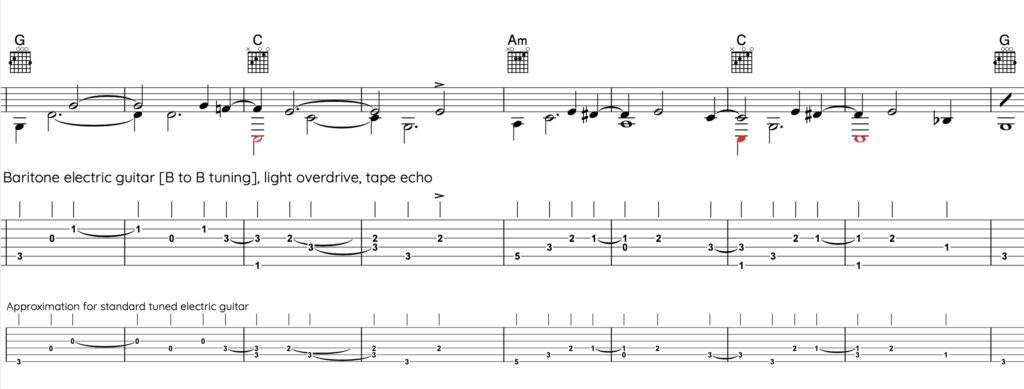
What’s your board looking like these days? Can you give us a general rundown of what amps and guitars you’re using?
My main guitar is a Fender American Elite Telecaster from (I think) 2019, all stock. I love that guitar. It’s so easy to play, and sounds so clean and clear. It came with an amazing setup from the factory—super low action but high enough that there isn’t any fret buzz, perfect intonation all the way up to the 24th (!!) fret—and I haven’t changed it much. It really has spoiled me.
When I’m used to the Tele and I have to pick up something that’s set up with higher action, it feels like I’m wearing a lead vest, so to speak. Lucy’s live bass player, Dominic Angelella, described the pickups as “hi-def” which is a pretty accurate way to describe their sound.
My first nice electric was a Deluxe Player’s Stratocaster from the early 2000s. I’ve had that guitar since I was like 13, and I’ve gradually upgraded pretty much every piece of hardware over the years. Sometimes I’ll bring it to a session, and the producer or artist will get a scared look in their eyes when I pull out the Strat.
I think it’s undeserved, but Strats sort of have this reputation of like a Guitar Center, blues lawyer, John Mayer worship kind of sound. My Strat is probably the least Strat-y Strat I’ve ever played, though. It has Lindy Fralin split blade pickups in it, which sound like something in between single coils and humbuckers, and don’t sound particularly Strat-y. I also put on new tuners and nut, and a Callaham bridge. If my Tele wasn’t so nice, I’d play the Strat a lot more….
My main acoustic is a 1980 Guild D35 that was my dad’s when he was a kid. He recently passed it on to me, since he doesn’t play it that much anymore, and I’ve been loving playing it. It’s the poor man’s Martin (maybe, don’t get mad at me, acoustic guitar purists). I also have an Eastman jumbo 12-string that I got right when the pandemic hit last March.
My main amp is a 1971 Princeton Reverb. In 2018 I became obsessed with Princetons and decided to start putting money aside for one. I finally got this one at the beginning of 2019, and I love it.
Some folks will say you need to get a blackface (pre 1968) or some will say 1965 is the cutoff… but they were still making them exactly the same for a few years after the change in 1969. They had to use up components and old stock and stuff. I’d challenge anyone to listen blindfolded to a 1964, 1968, and 1971 Princeton and tell me which is which!
I also have a 1969 Vibro Champ that I got at Richard’s Music Co. in Lawrence, Kansas. Amazing music store, and I got an amazing deal on the amp. I love that amp, and it probably gets more play day-to-day, since it sounds great at much lower volumes.
For future Lucy tours, I think I’m going to run a stereo setup with the Princeton and Vibro Champ. I tried that on the Colbert taping we did recently, and really loved the tone. Plus, it lets me use the stereo effects on my Strymon pedals!
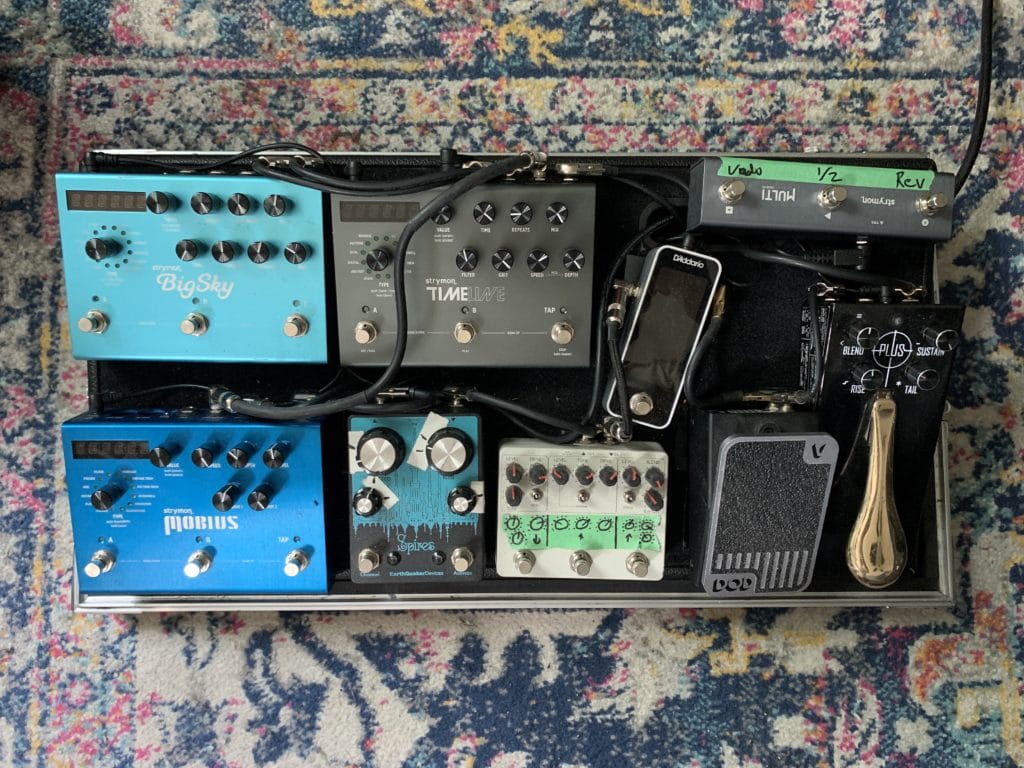
My board has slimmed down a little bit recently. I’ve always craved the sort of flexibility you can have in the studio in my live setup. Like how you can use a different drive on every song when recording.
Or even use one rig for a part and a whole different rig for the double. So I used to try and fit as many pedals on my board as physically possible. I had the biggest pedaltrain and probably had about 20 pedals crammed on there.
But it wasn’t practical, and it meant that my brain was divided when playing live. I also went through a phase where I was trying to cover some of the keyboard parts from the recordings with the Keith McMillan 12-step MIDI controller (I still think this is a cool device, it was just too much for me to do at once).
So, all that is to say that I’ve simplified slightly. I tore my whole board apart in 2020, since I knew I wasn’t going to have any gigs, and I recently put a new one together that I’m very happy with. I had a BigSky, and I recently added a TimeLine and Mobius. I love those pedals because they take the place of a bunch of other things that I used to have to keep on the board for like one song that has phaser, or one song that needs this delay and one that needs that one.
But now I can just have presets saved for each song, and there’s no risk of accidentally knocking a knob and getting something completely different than I expected.
So my current signal chain is: Tele -> Gamechanger Audio Plus Pedal -> DOD Mini Volume (the smallest volume pedal I’ve ever seen) -> D’Addario tuner -> Keeley Tone Workstation (Keeley somehow crammed his compressor, Katana Clean Boost, 1962 OD, and Red Dirt OD into one pedal) -> Earthquaker Devices Spires fuzz (two amazing fuzzes in one pedal) -> Strymon Mobius -> Strymon TimeLine (with the extra three-button footswitch for looper functionality) -> Strymon BigSky -> stereo out to the Vibro Champ and Princeton.
You mentioned you’re a fan of BigSky. What are some of your favorite uses for it? Any go-to settings or presets you always find yourself going to?
It’s true, I do love my BigSky! I have also been really loving getting to know Mobius and TimeLine, which are newer acquisitions for me. I have a pretty basic spring sound that I use a lot, and a basic room sound. 95% of the time, one of those two is on as part of my baseline sound.
But as for more exciting things (not that a basic spring reverb isn’t exciting!), “First Time” (I talked a little bit about the arrangement of this song earlier) features a really cool infinite verb sound on the clean electric leads.
I’m pretty sure we recorded that DI, just guitar -> BigSky -> DI. It was really funny recording with that sound, because if I made a slight mistake, I’d have to go down on my knees and twist the reverb time knob way down and back up again to cancel out the bad reverberations.
I’ve been working out how to do that part live, and I realized that I had been completely ignoring the infinite sustain/freeze feature on the Big Sky… felt silly, but I’m glad to know about it now.
I use some more big lush reverbs when playing some of Lucy’s older songs too. Like on a song from Lucy’s first record called “Direct Address,” I will turn on a big (maybe about 10-20 second decay?) reverb for this really fast tremolo picking part.
On the record we recorded a bunch of layers of her voice, and so the song was sounding really empty live without that. The reverb helps fill that same space and give it an ethereal sound. Things like that, rearranging things slightly live to capture the vibe of the recording, are something the Big Sky has come in clutch for time and time again. Doesn’t sound good yet? Add a little more reverb!!
We heard the news that Lucy announced her third album, Home Video, due later this year in June. What are you most excited about on this new record? Anything interesting you had the chance to do that you hadn’t in the past?
This new record is hands down the best thing I’ve ever worked on, and I think it’s Lucy’s best writing to date. It seems like the reception has been overwhelmingly positive for the three songs that have come out so far, and I’m so excited for people to hear the whole thing.
I think we were willing to do things that we never would have done on Historian or No Burden. In some ways it’s simpler, but it’s also lusher and more expansive. I think the truth is it is just better.
I think we have finally hit our stride in terms of arrangement and production, and I think the record is super interesting to listen to without feeling cluttered. I got to play keyboards a lot on this record, which was super fun for me. I think I played about half of the pianos and half of the synths on the record.
There’s so much that I love about the new record, I could go on and on about it. But here’s a couple specific things that tickle me in a special way:
I love the outro in “Hot and Heavy” so much. I’ve seen some people on Twitter comparing it to War on Drugs, which is apt. We used their song “Under The Pressure” as a specific reference a couple of times throughout this record, and it definitely had a big influence on “Hot and Heavy.” In the second half of the outro, when the strings come in and there are just so many layers of keyboards and feedback and things, it just makes me feel so good.
I keep talking about “First Time,” but I really am very excited about that one. We built the arrangement around a bass guitar going through the Hologram Electronics Dream Sequence.
I don’t feel like I fully understand how the Dream Sequence works, but I think it is like a combination pitch shifter, freeze pedal, and tremolo. You can hit a footswitch to grab a granular sample of whatever chord you’re playing, and program in a specific rhythmic tremolo, with the option for different bits to be shifted up or down an octave.
Or you can do what we did, which is put it on random mode and let it do its thing. That song also has a great infinite reverb moment, which we did with a clean guitar through the BigSky, and I think we just took a DI out of the pedal.
On a song called “Cartwheel,” I got to break out my fancy classical guitar, which was fun. I also play Mellotron and plucked autoharp on that song.
In general, I was excited to play more acoustic guitars on this record. Considering how much Lucy gets lumped in with “sad indie singer-songwriter” tropes, her first two records were very loud, very distorted, and had almost no acoustic instruments on them. The new record, though, has more variety in both the individual tones of each instrument and in the overall tone of each song. Collin introduced me to this cool recording technique on this record: you take a stereo condenser mic and put a guitar player on either side of it, facing each other with the mic in the middle. What we did was have one person play a standard-tuned acoustic and another play a high-strung. Then we double it like we would probably do anyways with a standard acoustic rhythm guitar, and pan each stereo take hard left and hard right. The high strung plus regular acoustic ends up sounding like this larger-than-life 12-string guitar. It’s super smeary and kind of indistinct, but sounds so special. We used that for the acoustics on Hot and Heavy, as well as on two others, “Brando” and “Please Stay”.
I could talk all day about all the cool little things that made it on the record, but I won’t do that now!
You guys are also scheduled to go on tour later in the fall. I can’t imagine how you must be feeling after not being able to tour or perform live for the majority of the last year. Anything you’re looking forward to the most for this tour? Any songs off the new record, or places you’ve been wanting to go back to?
I’m going to be holding my breath until September. I want to tour so badly, but we will definitely cancel if big indoor gatherings aren’t safe by then. That said, we all desperately want it to happen and be safe.
I’m really excited to go back to the Southwest. That’s probably my favorite region of the US. I love the infinite landscapes and the delicious Mexican/Southwestern food! I think I went 10 days on our last big tour eating nothing but burritos through the Southwest leg.
We’ve always had really fun times in Scandinavia, especially in Norway. The folks we’ve met have always been super friendly, and we’ve had some amazing meals there.
I’m really excited to play everything from the new record. The album closer, “Triple Dog Dare,” will definitely be a heavy hitter live. There’s a song called “Partner in Crime” that uses auto-tuned vocals in a really cool way, and I’m excited to see how that turns out live.
I’m really excited to see the audience reaction as well—that’s always the best part of a tour. There’s truly nothing in the world that can compare to hearing 1000 people singing louder than the PA. It’s an unreal feeling, and I know I’m not alone in hoping that will be our reality again soon….
Home Video will be out on June 25th via Matador Records. Catch Jacob on tour with Lucy Dacus this fall, and check out the video for her latest single, “Brando” here.
Subscribe to our newsletter to be the first to hear about new Strymon products, artist features, and behind the scenes content!

Explore Our First BigSky MX Preset Pack! As part of the latest Nixie 2 update, we’ve put together a free BigSky MX preset pack featuring sounds
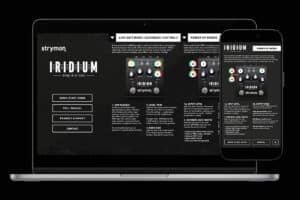
If you happen to be one of those Strymon owners who know that their favorite units might have some extra capabilities but can’t remember exactly
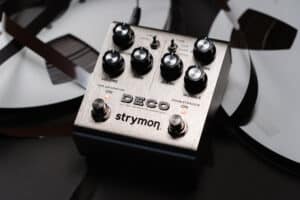
From our favorite artists’ new releases to amazing concerts, and existing artists we’re just finding out about, 2024 was a year filled with great music.